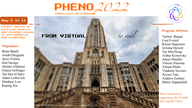Speaker
Description
Thermal friction offers a promising solution to the Hubble and the large-scale structure (LSS) tensions. This additional friction acts on a scalar field in the early universe and extracts its energy density into dark radiation, the cumulative effect being similar to that of an early dark energy (EDE) scenario. The dark radiation automatically redshifts at the minimal necessary rate to improve the Hubble tension. On the other hand, the addition of extra radiation to the Universe can improve the LSS tension. We explore this model in light of cosmic microwave background (CMB), baryon acoustic oscillation and supernova data, including the SH0ES H0 measurement and the Dark Energy Survey Y1 data release in our analysis. Our results indicate a preference for the regime where the scalar field converts to dark radiation at very high redshifts, asymptoting effectively to an extra self-interacting radiation species rather than an EDE-like injection. In this limit, thermal friction can ease both the Hubble and the LSS tensions, but not resolve them. We find the source of this preference to be the incompatibility of the CMB data with the linear density perturbations of the dark radiation when injected at redshifts close to matter-radiation equality.

